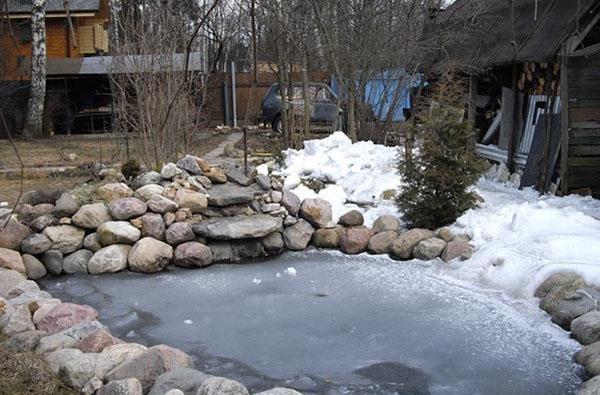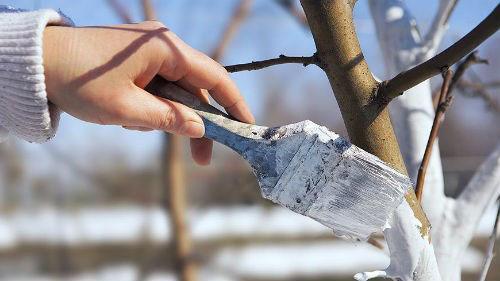It's time to open the summer season in March
 Many people who are not very knowledgeable in horticultural affairs believe that since the green grass has not yet made its way through the snow cover, then it is too early to get to work on their site. This is a misconception. Summer residents expect a lot of things that they are doing now, working for the benefit of the future harvest.
Many people who are not very knowledgeable in horticultural affairs believe that since the green grass has not yet made its way through the snow cover, then it is too early to get to work on their site. This is a misconception. Summer residents expect a lot of things that they are doing now, working for the benefit of the future harvest.

 Thus, the grower must prevent excessive heating of the bark. Either in autumn or early spring, it is necessary to spend whitewash the lower part of the trunk and the base of skeletal branches, which exceed 20 mm in diameter. If there is no whitewash, you can use snow, spruce branches or brushwood to create artificial shade in the required areas.
Thus, the grower must prevent excessive heating of the bark. Either in autumn or early spring, it is necessary to spend whitewash the lower part of the trunk and the base of skeletal branches, which exceed 20 mm in diameter. If there is no whitewash, you can use snow, spruce branches or brushwood to create artificial shade in the required areas.
Lapnik is also an excellent protection against hares and mice in winter.
 At the end of March, you should take care of planting chokeberries, gooseberries, strawberries, currants, cherries. The adjacent snow must be covered with sheets of cardboard, brushwood or spruce branches. Thus, you can delay the melting of snow for almost 2 weeks and protect delicate plants from spring frosts.
At the end of March, you should take care of planting chokeberries, gooseberries, strawberries, currants, cherries. The adjacent snow must be covered with sheets of cardboard, brushwood or spruce branches. Thus, you can delay the melting of snow for almost 2 weeks and protect delicate plants from spring frosts.
Improving soil drainage from melt water is another important item in the spring work schedule. If the area is sloping, sprinkle it with strips of humus or wood ash at intervals of several meters. In these areas, the ground will better absorb moisture from the melted snow.
 If the surface is flat, then the snow must be well tamped with your feet or rolled. This will slow down melting and prevent thawing. To reduce the evaporation of water, as well as slow down the early heating of the soil, areas without planting can be covered with film.
If the surface is flat, then the snow must be well tamped with your feet or rolled. This will slow down melting and prevent thawing. To reduce the evaporation of water, as well as slow down the early heating of the soil, areas without planting can be covered with film.
If you have not prepared the cuttings for grafting fruit and berry plants in the fall, you can do it in March.
Early to mid-March is the latest time to prepare the soil composition for growing vegetables (ideally, they should be prepared in the fall). If you do not know the specific composition for the crops you have, then you can use the universal formula:
- garden (or sod) land - 1 part;
- humus - 2 parts;
- sand mixed with a glass of wood ash - 1 part;
- superphosphate - 3 tbsp. l. on a bucket of mixture.
 It is better not to use shop soil in its pure form due to the fact that it has high acidity and is saturated with salts. It is best to mix it with another potting mix, achieving a 1: 1 ratio. Also add a glass of wood ash to it in the amount of 1 cup per bucket.
It is better not to use shop soil in its pure form due to the fact that it has high acidity and is saturated with salts. It is best to mix it with another potting mix, achieving a 1: 1 ratio. Also add a glass of wood ash to it in the amount of 1 cup per bucket.
 After that, let the earthy substance freeze well, and then pour it with a hot solution of potassium permanganate. These simple actions disinfect the soil well.
After that, let the earthy substance freeze well, and then pour it with a hot solution of potassium permanganate. These simple actions disinfect the soil well.
If sand is difficult to get, old sawdust can be used. Or take fresh, previously aged in a urea solution (2 tbsp. L. Per bucket)
 It is good to plant leeks, celery, cabbage and cauliflower, eggplant, tomatoes and peppers on such a mixture. Sowing these crops should be carried out in early March.
It is good to plant leeks, celery, cabbage and cauliflower, eggplant, tomatoes and peppers on such a mixture. Sowing these crops should be carried out in early March.
 Towards the end of March, early species are laid potatoes for germination and vernalization.This increases the plant's resistance to environmental changes, and also contributes to a reduction in crop maturity by almost 3 weeks.
Towards the end of March, early species are laid potatoes for germination and vernalization.This increases the plant's resistance to environmental changes, and also contributes to a reduction in crop maturity by almost 3 weeks.
 So that spring garlic stored at room temperature gives heads in the fall, place it in the refrigerator a month and a half before planting. There he will undergo the vernalization process.
So that spring garlic stored at room temperature gives heads in the fall, place it in the refrigerator a month and a half before planting. There he will undergo the vernalization process.
Onions should be planted as early as possible in spring, but only after the soil is ripe. It is not difficult to check this - if the earth does not stick to the shovel during digging, then the soil is ready.
 Remember to check stored vegetables for rotten fruits. Be sure to sort out potatoes and carrots. Remove bad tubers from the mass.
Remember to check stored vegetables for rotten fruits. Be sure to sort out potatoes and carrots. Remove bad tubers from the mass.
 Examine carefully the branches of the currant bushes in March. If you see bloated kidneys, they are most likely home to kidney mites. Collect and destroy them, otherwise, with the arrival of heat, the mite will crawl out and multiply throughout the plant. If the entire branch is affected by a large number of such buds, it should be removed completely and burned.
Examine carefully the branches of the currant bushes in March. If you see bloated kidneys, they are most likely home to kidney mites. Collect and destroy them, otherwise, with the arrival of heat, the mite will crawl out and multiply throughout the plant. If the entire branch is affected by a large number of such buds, it should be removed completely and burned.
 The beginning of spring is a time to spend trimming your trees and shrubs. Apples, pears, plums and other fruit trees require it for crown formation, as well as for good summer yields. Pruning is one of the key jobs in the country at this time.
The beginning of spring is a time to spend trimming your trees and shrubs. Apples, pears, plums and other fruit trees require it for crown formation, as well as for good summer yields. Pruning is one of the key jobs in the country at this time.
Sometimes the preparatory hassle in early spring is even greater than at the time of sowing and harvesting. However, timely implementation of the described procedures will help your garden to flourish, and your efforts will be greatly rewarded.